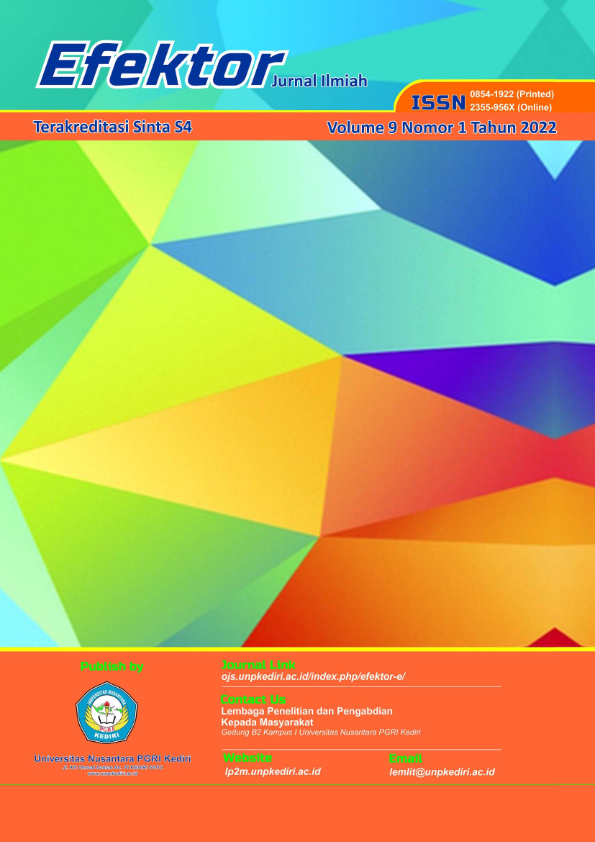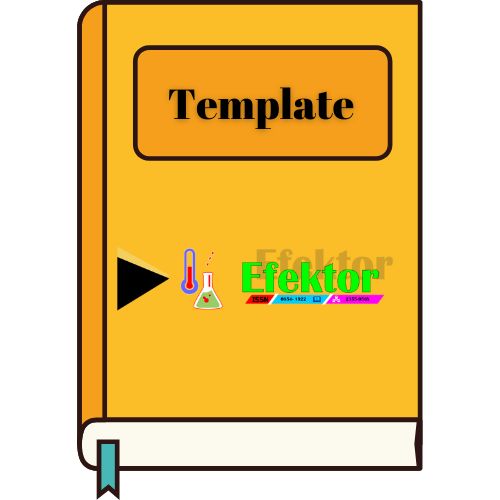Development of Website Chatbot Media Learning Data Presentation Materials Based on Problem Solving In Grade 4th Elementary School
DOI:
https://doi.org/10.29407/e.v9i1.16348Keywords:
Data presentation, Website, Chatbot, Media, Learning, Problem-solvingAbstract
This research was conducted to determine the feasibility of the learning media website chatbot based on problem-solving in present data for grade 4 elementary school at SDN Kapuk 05 Pagi. This study used research and development as the research method with four stages 4-D Thiagarajan development model, namely: 1) define, 2) design,3) develop, and 4) disseminate. The product of this research was a website chatbot learning media based on problem-solving in present data for grade IV elementary school. The feasibility level based on the results of the percentage assessment of material experts got 78%, learning media experts got 95.5%, linguists got 85%, the instructional design got 92%, one to one evaluation 90,9%, small group evaluation 84%, field test 82,1%, and teacher response assessment results produced was 93,75 %. Based on this result, it could be concluded that website chatbot learning media based on problem learning achieved the category of “very good” and "very decent" to be used as mathematics learning media for present data.
References
Surat Edaran Kementerian Pendidikan dan Kebudayaan Nomor 15 Tahun 2020 tentang Pedoman Penyelenggaraan Belajar dari Rumah dalam Masa Darurat Penyebaran Corona Virus Disease (COVID-19)
Najib Ahmad Donas dan Elhefni. (2016). “Pengaruh Penerapan Pembelajaran Bermakna (Meaningfull Learning) Pada Pembelajaran Tematik IPS Terpadu Terhadap Hasil Belajar Siswa Kelas III di MI”, Jurnal Ilmiah PGMI, Volume 2, Nomor 1, (http://jurnal.radenfatah.ac.id), diunduh pada tanggal 6 Agustus 2021
Mukuka Angel, dkk . (2021). “Students’ experiences with remote learning during the COVID-19 school closure: implications for mathematics education”, Heliyon 7 (2021) e07523, (https://doi.org/10.1016/j.heliyon.2021.e07523), h. 7 diunduh pada tanggal 8 Agustus 2021
Putria Hilna, Maulana Lutfi Hamdani, dan Uswatun Azwar Din. (2020). “Analisis Proses Pembelajaran dalam Jaringan(DARING) Masa Pandemi COVID-19 pada Guru Sekolah Dasar”, Jurnal Research & Learning in Elementary Education, Volume 4, Nomor 4 Tahun 2020, (https://jbasic.org/), h. 871 diunduh tanggal 20 Desember 2020
Yuan Yun-Peng, dkk. (2021). “Can COVID-19 pandemic influence experience response in mobile learning” , Telematics and Informatics journal, 64 (2021) 101675, (https://doi.org/10.1016/j.tele.2021.101676), h.12 diunduh tanggal 6 Agustus 2021
Hulukati Evi, dkk . (2021). “Deskripsi Penggunaan Media E-Learning dalam Pembelajaran Matematika di Masa Pandemi Covid-19” , Jambura Journal Of Mathematics Education, (http://doi.org/10.34312/jmathedu.v2i1.10061), Volume 2, No.2 , h.26 diunduh pada tanggal 6 Agustus 2021
Rusman. (2014). “Penerapan Pembelajaran Berbasis Masalah” , Edutech (https://ejournal.upi.edu), volume 1, No,2, 2014, diunduh pada tanggal 6 Agustus 2021
Winaryati Eny. (2018). “Penilaian Kompetensi Siswa Abad 21”, Prosiding Edusaitek, ISBN : 978-602-5614-35-4, (http://jurnal.unimus.ac.id) h. 11 diunduh tanggal 20 Desember 2020
Setyadi Danang dan Qahar ABD.. (2017). “Pengembangan Media Pembelajaran Matematika Berbasis Web pada Materi Barisan dan Deret”, Jurnal Matematika Kreatif-Inovatif, Vol. 8, Nomor 1, (http://journal.unnes.ac.id), h. 7 diunduh tanggal 1 Desember 2020
Arsisari Ayen, dkk. (2021). “Analisis Efektifitas Pembelajaran Matematika Secara Daring Siswa SMP di Bangka Belitung Pada Masa Pandemi Covid-19”, Jurnal Pendidikan Matematika, (https://www.scholar.ummetro.ac.id), Volume 2, No.1, 2021, h.78 diunduh pada tanggal 6 Agustus 2021
Rhomdani Wahid Rohmad. (2017). “Pengembangan Media Pembelajaran Matematika Berbasis Web Menggunakan Blog Math (Blogger & Mathjax) di MtsN 5 Arjasa Jember”, Jurnal Matematika dan Pendidikan Matematika (DOI: 10.26594/jmpm.v2i2.1011), Volume 2, Nomor 2, 2017, h. 154 diunduh pada tanggal 6 Agustus 2021
Sudiatmika Abdi Gede Putu I dan Dewi Santhi Hari Komang. (2020). “E-Learning Berbasis Telegram Bot”, Jurnal Riset Inovasi Bidang Informatika dan Pendidikan Informatika(KERNEL), Vol. 1, No. 2, 2020 , (https://ejurnal.itats.ac.id), h. 49 diunduh tanggal 20 Agustus 2021
Laksana Wahyu Septiawan Fadhil dan Fiangga Shofan . (2022). “The Development of Web-Based Chatbot as a Mathematics Learning Media on System of Linear Equations in Three Variables”, Jurnal Ilmiah Pendidikan Matematika Volume 11, Nomor 1, (https://ejournal.unesa.ac.id), h. 153, diunduh pada tanggal 23 Maret 2022
Mashuri Sufi. (2019). Media Pembelajaran Matematika. Yogyakarta: Penerbit Deepublish
Sugiyono. (2019). Metode Penelitian & Pengembangan. Bandung: Alfabeta
Fernando dan M. Christanti Viny. (2021). “Rancangan Aplikasi Bimbingan Belajar Bahasa Inggris yang dikelola Kelompok Kerja Guru Jakarta Barat”, Jurnal Seri Seminar Nasional Ke-III Universitas Tarumanagara, (https://journal.untar.ac.id), h. 1735, diunduh pada tanggal 24 Maret 2022
Dhamantara Yoga dan Ulhaq Zuhdi. (2022). “Pengembangan Aplikasi Chatbot Whatsapp Materi Pesawat Sederhana Bagi Siswa Kelas V Sekolah Dasar”, Jurnal Penelitian Pendidikan Guru Sekolah Dasar, Volume 10, Nomor 1, (https://ejournal.unesa.ac.id), h. 119, diunduh pada tanggal 24 Maret 2022
Jesslyn, Mawardi Christanti Viny, dan Hendryli Janson. (2021). “Penerapan Teknologi Dalam Percakapan Virtual Sebagai Sarana Pembelajaran di Sekolah Dasar Immanuel”, Seri Seminar Nasional Ke-III Universitas Tarumanagara, (https://journal.untar.ac.id), h. 1486, diunduh pada tanggal 24 Maret 2022
Akdon, Riduwan. (2013). Rumus dan Data dalam Analisis Statistika. Bandung: Alfabeta
Cahani Khoirunnisa. (2021). “Kemampuan Pemahaman Konsep Matematika Siswa Ditinjau dari Konsentrasi Belajar Pada Materi Statistika Dasar” , Jurnal Pendidikan Matematika Inovatif, (DOI: 10.22460/pjmi.v4i1.215-224), volume 4, no.1 , 2022, h.223 diunduh pada tanggal 6 Agustus 2021
Downloads
Published
Issue
Section
License
Authors who publish with this journal agree to the following terms:
- Copyright on any article is retained by the author(s).
- The author grants the journal, the right of first publication with the work simultaneously licensed under a Creative Commons Attribution License that allows others to share the work with an acknowledgment of the work’s authorship and initial publication in this journal.
- Authors are able to enter into separate, additional contractual arrangements for the non-exclusive distribution of the journal’s published version of the work (e.g., post it to an institutional repository or publish it in a book), with an acknowledgment of its initial publication in this journal.
- Authors are permitted and encouraged to post their work online (e.g., in institutional repositories or on their website) prior to and during the submission process, as it can lead to productive exchanges, as well as earlier and greater citation of published work.
- The article and any associated published material is distributed under the Creative Commons Attribution-ShareAlike 4.0 International License













